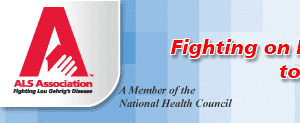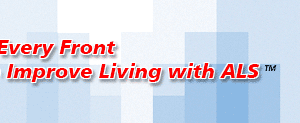

 |
 |
Annual Neuroscience Gathering: ALS Advances at a GlanceThe 2007 annual meeting of the Society for Neuroscience in San Diego November 03-07 provides ALS researchers from around the world an opportunity to learn of the most recent advances in the field that will lead towards more effective therapy. Platform presentations and poster sessions will highlight important progress in understanding what goes wrong to produce ALS and how to develop new strategies for treating the disorder. Symposia throughout the meeting will focus on developing areas of research with direct implications for ALS. The ALS Association is making available this preview of the meeting with emphasis on new developments relevant to the disease:
Other new findings of interest in the ALS field to be presented in platform talks Saturday, Sunday, and Wednesday include important advances such as promise of gene therapy approaches in ALS, role of progranulin and TDP-43 biology in ALS, initial Phase II results with a drug candidate, cautionary information about another proposed drug treatment, lithium, in ALS, as well as more than a hundred poster presentations on ALS Sunday through Wednesday. Concise Guide of ALS relevant sessions at Neuroscience 2007 in San DiegoSaturday, November 03, 2007 1- 5:00 pm Slides, Room 32A: Motor Neuron Disease: Animal Models, Therapeutics A way to show in lab cell culture the earliest signs of ALS, stem cell findings in models of the disease, and an immunization strategy for treating it, along with the Phase II findings that the Trophos drug candidate is well tolerated in ALS patients. Sunday, November 04, 2007 Posters 8-noon 160.1/W8, 160.5/W12, 160.7/W14, 160.9/W16, 160.14/X1, 160.16/X3, 160.17/X4, 161.1/X6, 161.4/X9, 161.6/X11, 161.7/X12, 161.10/X15, 161.13/X18; 160.4/W11, 160.8/W15, 162.11/Y1 Sunday 1- 5 pm Posters 313.1/GGG4, 290.7/NN21 4-4:30 pm Slides, Room 24A: Tau and Cytoskeleton in Neurodegeneration Models and Mechanisms: role of progranulin and TDP-43 biology in ALS, and the imaging of a continuum of TDP-43 inclusions in ALS. Monday, November 05 Posters 8:00 am - 9:00 am: 345.13/C19, 414.5/AAA26; 1 - 5:00 pm: 478.4/R11; 488.3/Y2, 488.6/Y5, 488.23/Y22, 488.26/Y25, 489.2/Y27; 489.4/Z1, 489.6-9/Z3-6, 489.12-24/Z9-21, 489.26-29/Z23-26 ; 490.1-4/AA2-5, 490.7/AA8, 490.8/AA9, 490.11/AA12, 490.15/AA16; 517.11/UU27 ; 495.14/EE18 Tuesday, November 06 Posters 8-noon 591.5/U21: Cautionary note on proposed use of lithium in ALS; Further evidence for role of angiogenin in ALS: 591.4/U20, 591.20/V8. Therapeutic avenues and biomarkers: 591.2/U18, 591.6/U22, 591.7/U23. Also of interest: 602.16/DD16; cycad toxin investigations: 604.9/EE19 and also in afternoon posters and 679.16/F45, 686.3/I8, 726.1/MM20. Additional Tues. Posters of interest, 1 - 5:00 pm: 674.16/E7, 692.12/N2, 726.2/NN1 Wednesday, November 07 Slides, Room 24A: Neurodegenerative Disorders and Movement Disorders 9:15 - 9:30 am 762.6 variants in genes for chromogranins 10:00 - 10:15 am 762.9 location and aggregation of TDP-43 in a new cell culture model Posters 9:00 am - 11:00 am 803.10/T21 and 803.11/T22 |
|
| |||
The ALS Association �2004 The ALS Association. All rights reserved. Contact the Webmaster |